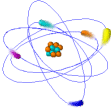
Life Sciences
Artificial Form of Life

 |
Life Sciences Artificial Form of Life |
 |
|
Scientists Create Artificial Form of
Life U.S. scientists
have created an artificial form of life from synthetic genes. The form
they made is a virus, in this case, a man-made version of a real virus
that eats bacteria. Although it isn't the first synthetic virus, it
was constructed more quickly and is more accurate than any made in previous
attempts.
The virus known as Phi-X is a simple, well-studied organism that is harmless to humans. In 1978, it became the first form of life whose genetic code scientists deciphered. That is, they documented the sequence of chemicals that make up its DNA, the material that determines the physical characteristics of every living thing. Researcher Craig Venter and colleagues from the Institute for Biological Energy Alternatives have now stitched together pieces of commercially available DNA to build an entire functional Phi-X virus in their laboratory near Washington. "The team was actually more successful than any of us imagined, and we got viruses with 100 percent of the activity, showing that the synthesis method was very robust," he said. Researchers had previously created an artificial poliovirus by stringing together DNA fragments and then letting a naturally occurring enzyme transform the string into proteins that ultimately formed an infectious microbe. But that process took three years and produced organisms with defective genes. In contrast, the Phi-X virus took only 14 days to make and it was without defects. In a paper to be published in a U.S. National Academy of Sciences journal, Mr. Venter's group says their synthetic microbe was able to infect and kill bacterial cells as efficiently as the natural one. "It's not just an accuracy issue," he said. "It's the ability to actually make much larger molecules than were possible before in a single step. This is a robust new step that allows us to make much larger pieces." The researchers call this a demonstration of a principle that can serve as a stepping stone to manipulating more complex organisms hundreds or thousands of times larger than Phi-X. The project was funded by the U.S. Department of Energy, which is seeking to develop biological methods of energy production and create organisms that can help clean the environment. "So just imagine in the no-too-distant future a colony of specially designed microbes living with the emission-control systems of a coal-fired plant," said Spencer Abraham head of the agency, "consuming its pollution and its carbon dioxide, which will make fossil fuels as clean an energy source as hydro [water] power. Or consider the possibility of employing microbes to radically reduce polluted waters or to reduce the toxic effects of radioactive waste." Secretary Abraham calls the research a key step in efforts
to understand how biological systems work. He says future applications
of this technology might bring about better vaccines, improve yields
of farm crops that are more resistant to disease, and enhance the ability
to detect biological threat agents. |